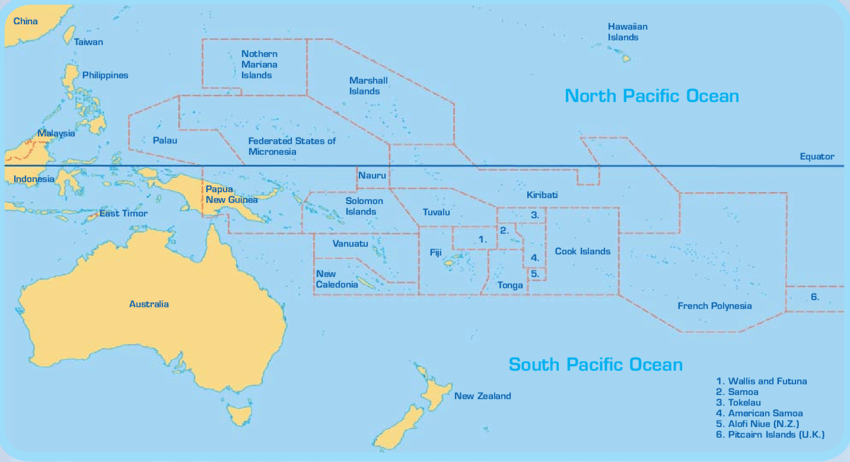Description

Copyright infringement is not intended
Context: During a meeting with the 14 Pacific Island Countries, China’s effort to push through a comprehensive framework deal, the draft of which was leaked earlier, failed to gain consensus among the PICs.
What are PICs?
- The Pacific Island Countries are a cluster of 14 states which are located largely in the tropical zone of the Pacific Ocean.
- These countries have played an important role in major power rivalry as springboards for power projection and laboratories for developing and demonstrating strategic capabilities.
- The PICs lie in the natural line of expansion of China’s maritime interest.
- At a time when the Quadrilateral Security Dialogue has emerged as a major force in the Indo-Pacific vis-à-vis China, the need to influence the PICs becomes even more pressing for China.
- They include Cook Islands, Fiji, Kiribati, Republic of Marshall Islands, Federated States of Micronesia (FSM), Nauru, Niue, Palau, Papua New Guinea, Samoa, Solomon Islands, Tonga, Tuvalu and Vanuatu.
- The islands are divided on the basis of physical and human geography into three distinct parts — Micronesia, Melanesia and Polynesia.
What is the strategic significance of the PICs?
- The islands are very small in land area, and are spread wide across the vast equatorial swathe of the Pacific ocean. As a result, though they are some of the smallest and least populated states, they have some of the largest Exclusive Economic Zones (EEZs) in the world.
- Large EEZs translate into huge economic potential due to the possibility of utilising the wealth of fisheries, energy, minerals and other marine resources present in such zones. Hence, they prefer to be identified as Big Ocean States, rather than Small Island States.
- In fact, Kiribati and FSM, both PICs, having EEZs larger than that of India.
- Moreover, these countries have played an important role in major power rivalry as springboards for power projection and laboratories for developing and demonstrating strategic capabilities.
- The major powers of the colonial era competed with each other to gain control over these strategic territories.
- The Pacific islands also acted as one of the major theatres of conflict during the Second World War — between imperial Japan and the U.S. Due to the remoteness of these islands from the Soviet Union and major population centres of the world, some of the major nuclear weapon test sites of the U.S., the U.K. and France were located here.
- In addition, the 14 PICs, bound together by shared economic and security concerns, account for as many number of votes in the United Nations, and act as a potential vote bank for major powers to mobilise international opinion.
What does China seek to achieve from the PICs and how?
- China does not have any particular historical linkages to the PICs unlike the Western powers. Therefore, its interest in the PICs is of relatively recent origin, and is linked to China’s rise in the past few decades.
- The PICs lie in the natural line of expansion of China’s maritime interest and naval power.
- They are located beyond China’s ‘First Island Chain’, which represents the country’s first threshold of maritime expansion.
- The PICs are located geo-strategically in what is referred to by China as its ‘Far Seas’, the control of which will make China an effective Blue Water capable Navy — an essential prerequisite for becoming a superpower.
- At a time when the Quadrilateral Security Dialogue has emerged as a major force in the Indo-Pacific vis-à-vis China, the need to influence the PICs have become an even more pressing matter for China.
- Apart from the vast marine richness of the PICs, the Taiwan factor plays a major role in China’s Pacific calculus. China, which considers Taiwan to be a breakaway territory, is preparing for what seems like an inevitable military invasion.
- In this context, it becomes important to break Western domination of island chains of the Pacific which could impede reunification.
- Wooing the PICs away from the West and Taiwan will therefore make the goal of Taiwan’s reunification easier for China. China has been successful in getting diplomatic recognition from 10 out of the 14 PICs through its economic largesse. Only four PICs — Tuvalu, Palau, Marshall Islands and Nauru, currently recognise Taiwan.
What are the implications of China’s latest move?
- China has increasingly started talking about security cooperation in addition to its economic diplomacy towards the PICs.
- In April 2022, China signed a controversial security deal with the Solomon Islands, which raised regional concerns. The secrecy surrounding the draft, and the haste with which it was discussed with the governments of the PICs during the meeting sent worrying signals across the Pacific.
- The PICs as a collective did not agree to China’s extensive and ambitious proposals, and therefore China failed to get a consensus on the deal.
- The intensification of China’s diplomacy towards the Pacific Islands have made the powers who have traditionally controlled the regional dynamics like the U.S. and Australia more cautious.
- The U.S. has started revisiting its diplomatic priority for the region ever since the China-Solomon Islands deal.
- Australia, in the meanwhile, has sent its Foreign Secretary to the islands for revitalising ties, with promises of due priority and assistance to the PICs.
https://epaper.thehindu.com/Home/ShareArticle?OrgId=G7C9SNPKG.1&imageview=0
1.png)















